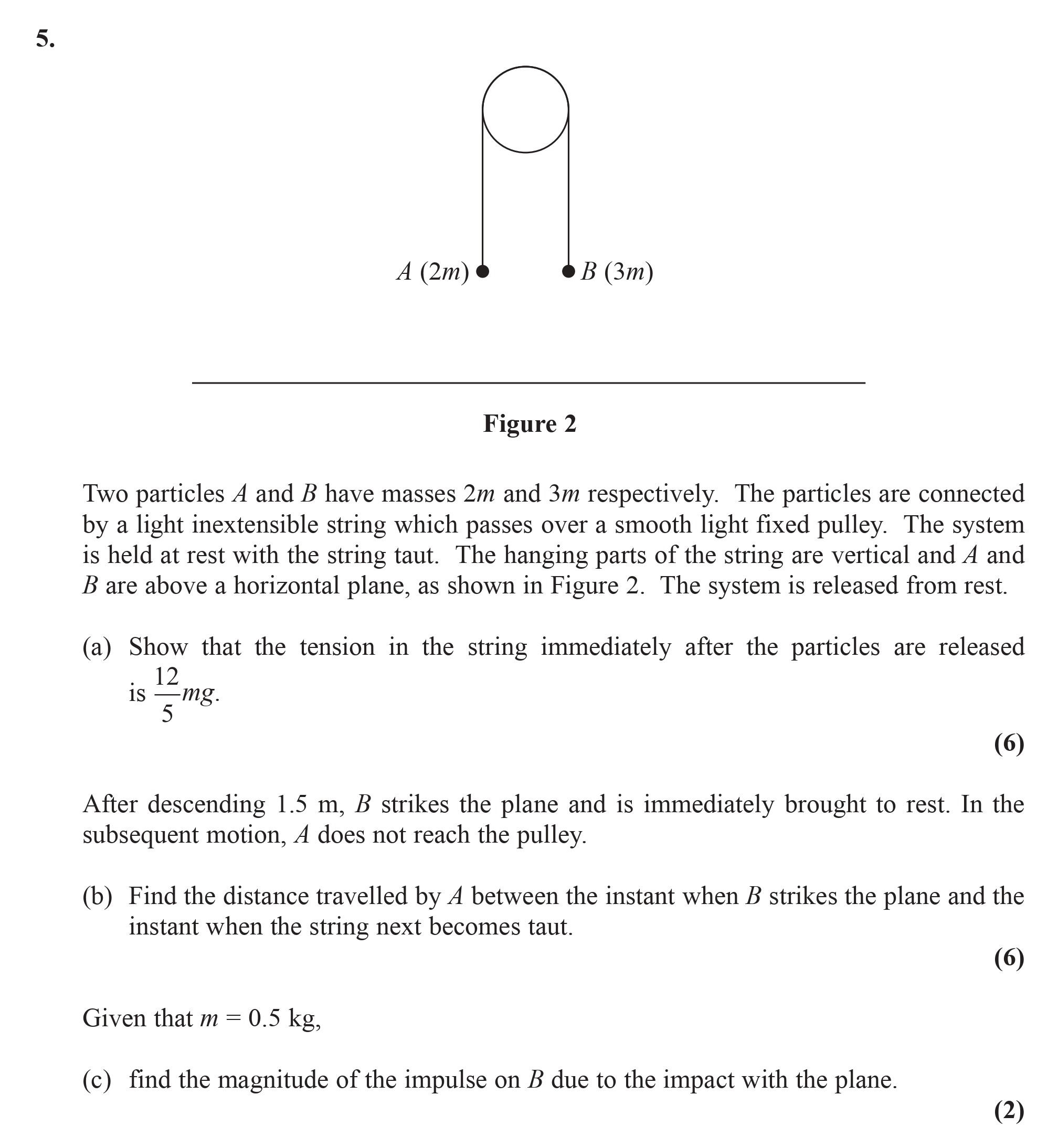Photo AI
Two particles A and B have masses 2m and 3m respectively - Edexcel - A-Level Maths Mechanics - Question 5 - 2014 - Paper 2
Question 5

Two particles A and B have masses 2m and 3m respectively. The particles are connected by a light inextensible string which passes over a smooth light fixed pulley. T... show full transcript
Worked Solution & Example Answer:Two particles A and B have masses 2m and 3m respectively - Edexcel - A-Level Maths Mechanics - Question 5 - 2014 - Paper 2
Step 1
Show that the tension in the string immediately after the particles are released is \( \frac{12}{5} mg \)
Answer
To find the tension ( T ) in the string immediately after the release of the particles, we start by analyzing the forces acting on both particles:
-
For particle A (mass = ( 2m )): The forces are the tension ( T ) acting upwards and the weight acting downwards, which is ( 2mg ). Applying Newton's second law, we have: [ 2mg - T = 2ma \tag{1} ]
-
For particle B (mass = ( 3m )): The only forces acting are the weight ( 3mg ) downwards and the tension ( T ) upwards. Using Newton's second law: [ 3mg - T = 3ma \tag{2} ]
By manipulating equations (1) and (2), we can eliminate ( a ). From (1): [ T = 2mg - 2ma ag{3} ]
From (2): [ T = 3mg - 3ma ag{4} ]
Setting (3) equal to (4): [ 2mg - 2ma = 3mg - 3ma ]
Solving for ( a ): [ mg = ma ightarrow a = \frac{g}{5} ]
Substituting back into either (3) or (4) gives: [ T = 3mg - 3m\left(\frac{g}{5}\right) = 3mg - \frac{3mg}{5} = \frac{15mg}{5} - \frac{3mg}{5} = \frac{12mg}{5} ]
Hence, the tension in the string immediately after the release is ( \frac{12}{5} mg ).
Step 2
Find the distance travelled by A between the instant when B strikes the plane and the instant when the string next becomes taut.
Answer
Using the equations of motion for particle A:
- The initial velocity ( u = 0 ) (as A was at rest before B strikes the plane).
- The distance B travels downwards is ( s = 1.5 , \text{m} ), and during this motion, A starts to move upwards.
- We also need the acceleration for A: [ a = \frac{g}{5} ]
Using the second equation of motion for A: [ s = ut + \frac{1}{2} a t^2 ightarrow 1.5 = 0 + \frac{1}{2} \left(\frac{g}{5}\right) t^2 ightarrow 1.5 = \frac{1}{10} g t^2 ]
Substituting ( g \approx 10 , \text{m/s}^2 ): [ 1.5 = \frac{10}{10} t^2 ightarrow t^2 = 1.5 ightarrow t = \sqrt{1.5} \approx 1.22 , \text{s} ]
Now, substituting back to find the distance travelled by A: [ s_A = ut + \frac{1}{2} a t^2 = 0 + \frac{1}{2} \left(\frac{g}{5}\right) (1.22)^2 \approx 0.36 , \text{m} ]
Therefore, the distance travelled by A is approximately ( 0.36 , \text{m} ).
Step 3
Find the magnitude of the impulse on B due to the impact with the plane.
Answer
To calculate the impulse experienced by B upon impact with the plane, we can use the formula: [ ext{Impulse} = m(v - u) ]
Where:
- ( m = 3m )
- ( u = v ) (initial velocity just before impact)
- After impact, ( v = 0 ).
The final velocity ( v ) just before impact can be calculated from: [ v^2 = u^2 + 2as ] Setting ( u = 0 ), ( a = g ) and ( s = 1.5 , m ightarrow ext{(distance B travels)}: [ v^2 = 0 + 2 \times g \times 1.5 = 3g ightarrow v = \sqrt{3g} ]
Substituting:\n [ ext{Impulse} = 3m (0 - \sqrt{3g}) = -3m \sqrt{3g} ightarrow ext{(magnitude is positive)} ightarrow |\text{Impulse}| = 3m \sqrt{3g} ]
Now substituting ( m = 0.5 , kg ) and ( g = 10 , m/s^2 ): [ = 3(0.5)\cdot\sqrt{30} = 1.5\cdot\sqrt{30} ext{Ns} \approx 3.67 , ext{Ns} ]
Thus, the magnitude of the impulse on B is approximately ( 3.67 , ext{Ns} ).
